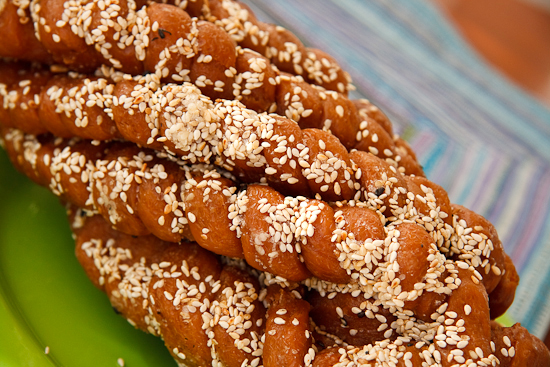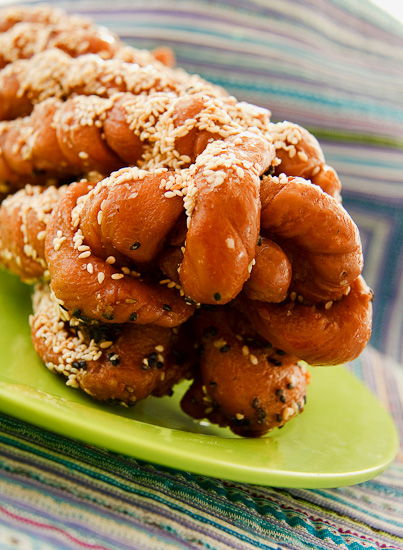Have you seen the mahua truck? It appears only after dark, lurking on dimly lit street corners. You can recognize it by the large glass cabinet that sits in the flatbed, stacked high with deep-fried, braided dough twists.
Mobile food is quite common in Beijing – think jianbing and candied hawberries – but they usually rely on pedal-powered transportation. I rarely ever see snack foods sold from gas-guzzling vehicles, until within a short span of weeks I saw not one but three mahua trucks. Is this the new trend?
Mahua (麻花) are a specialty of Tianjin, about 100km east of Beijing. They resemble the larger, more complex braided loaves of challah, but they’re actually quite hard, crunchy, deep-fried, and glazed in a syrup of rock sugar or sometimes honey. I like them in small quantities, but these are seriously hefty: one whole log would make a very good weapon against intruders, or perhaps a doorstop for your palace gates. No wonder they need trucks to haul them all around.
Some observations about mahua trucks:
1. They all claim to be selling Tianjin mahua, though their license plates are invariably from some other province. They get a bit shifty-eyed when you ask them to explain this discrepancy and bluster away the answer.
2. They all drive the same model of mini-truck.
3. They only appear after dark.
4. One of them claims Yabao Lu as one of his favorite haunts.
5. There’s always 2-3 sellers lounging around the mini-truck. This is not unlike how the Xinjiang apricot-nut cake sellers bunch together, and it sometimes has the same menacing effect. The mahua sellers also carry a large knife to saw apart their massive, brick-like dough twists.
I may be imagining things, but all the evidence here points to the existence of a mahua gang, or at the very least a mahua smuggling ring. Are they dedicated to bringing Tianjin’s much-lauded snack food to the rest of China? Or do they have some more sinister purpose? Perhaps the most effective concealment for contraband is a heap of deep-fried sweets that can reputedly keep for over 3 months in the winter… (supposedly mahua are made and fried in a way that there is no moisture, which prevents it from spoiling)
I of course bought a mahua out of curiosity. Not only did I want to see how long I could keep it going in my cabinet of curiosities, but they also looked much better than the packaged variety that one normally finds in Beijing. There were a multitude of flavors available, including chestnut, walnut, jujube (Chinese dates), honey, and even more that I can’t remember. I opted for chestnut (it seemed seasonal, though in retrospect not the most exciting choice).
Upon my first nibbles, however, no flavor other than that of sugar, dough, and sesame could be discerned. After some research, I discovered that all the flavor is apparently contained in one braid in the center of the mahua. It’ll take patience and perhaps months for me to get there, unless I decide to host a mahua-eating party or something. I’m not really holding my breath.
If you want to try to find the mahua men, they are in the Yabao Lu (雅宝路) area “almost every night”, on Xinzhong Jie (新中街) west of Hotel G/Destination/Gongti West Gate about once a week, and at the Qinghua Donglu (清华东路) and Wangzhuang Lu (王庄路) intersection north of Wudaokou. They’re RMB 12 per jin (half-kilo); you can ask for half a mahua, which will weigh about 1kg.






































I observed exactly the same phenomenon with the mahua trucks in a very small city in Shandong Province, although sometimes I’d see them around in the daytime, too.